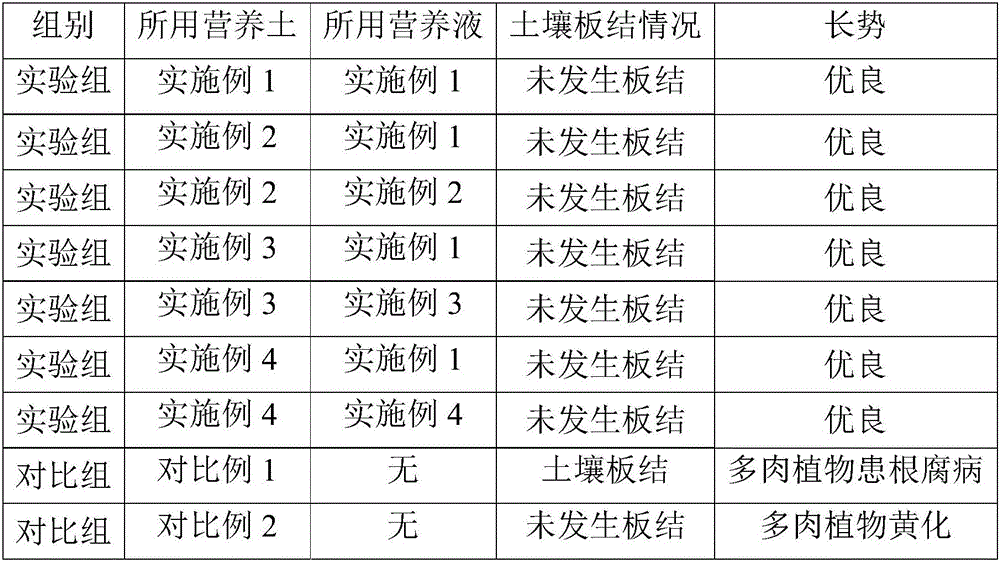Nutrient soil and method for succulent plant cultivation
A technology for succulent plants and nutrient soil, which is applied in the directions of botanical equipment and methods, cultivation, culture medium, etc., can solve the problems of unfavorable succulent growth, lack of thermal insulation performance, and lack of disease and insect pest control, so as to improve the ability to resist diseases and insect pests. , The production method is convenient, and the drainage effect is good.
- Summary
- Abstract
- Description
- Claims
- Application Information
AI Technical Summary
Problems solved by technology
Method used
Image
Examples
Embodiment 1
[0049] The nutrient soil is prepared in parts by weight: 20 parts of aerated concrete balls, 10 parts of bamboo charcoal granules, 30 parts of fairy soil, 10 parts of red jade soil, 8 parts of medical stone, and 5 parts of rice husk charcoal.
[0050] Among them, the diameter of the aerated concrete ball is 3 mm, the diameter of the bamboo charcoal particle is 3 mm, the diameter of the red jade soil is 2-6 mm, and the diameter of the medical stone is 2-6 mm.
[0051] Lay the aerated concrete balls on the bottom layer of the pot, lay the bamboo charcoal granules on the top layer of the pot, and mix the rest of the ingredients according to the ratio and lay them on the middle layer of the pot.
[0052] Prepare nutrient solution, the composition of every liter of nutrient solution is: potassium dihydrogen phosphate 200mg, magnesium sulfate 50mg, ferrous sulfate 100mg, potassium nitrate 500mg, scutellaria baicalensis essence 15g and Houttuynia cordata essence 15g, all the other are d...
Embodiment 2
[0055] The nutritious soil is prepared in parts by weight: 30 parts of aerated concrete balls, 15 parts of bamboo charcoal granules, 40 parts of fairy soil, 5 parts of red jade soil, 10 parts of medical stone, and 5 parts of rice husk charcoal.
[0056] The diameter of the aerated concrete ball is 5mm, the diameter of the bamboo charcoal particles is 5mm, the diameter of the red jade soil is 2-6mm, and the diameter of the medical stone is 2-6mm.
[0057] Lay the aerated concrete balls on the bottom layer of the pot, lay the bamboo charcoal granules on the top layer of the pot, and mix the rest of the ingredients according to the ratio and lay them on the middle layer of the pot.
[0058] Prepare nutrient solution, the composition of every liter of nutrient solution is: potassium dihydrogen phosphate 300mg, magnesium sulfate 100mg, ferrous sulfate 50mg, potassium nitrate 600mg, scutellaria baicalensis essence 10g and Houttuynia cordata essence 20g, the rest is deionized water, a...
Embodiment 3
[0061] The nutrient soil is prepared in parts by weight: 40 parts of aerated concrete balls, 25 parts of bamboo charcoal granules, 50 parts of fairy soil, 20 parts of red jade soil, 15 parts of medical stone, and 15 parts of rice husk charcoal.
[0062] The diameter of the air-entrained concrete ball is 10mm, the diameter of the bamboo charcoal particles is 10mm, the diameter of the red jade soil is 2-6mm, and the diameter of the medical stone is 2-6mm.
[0063] Lay the aerated concrete balls on the bottom layer of the pot, lay the bamboo charcoal granules on the top layer of the pot, and mix the rest of the ingredients according to the ratio and lay them on the middle layer of the pot.
[0064] Prepare nutrient solution, the composition of every liter of nutrient solution is: potassium dihydrogen phosphate 400mg, magnesium sulfate 150mg, ferrous sulfate 150mg, potassium nitrate 500mg, scutellaria baicalensis essence 20g and Houttuynia cordata essence 5g, the rest is deionized ...
PUM
| Property | Measurement | Unit |
|---|---|---|
| Diameter | aaaaa | aaaaa |
| Diameter | aaaaa | aaaaa |
| Diameter | aaaaa | aaaaa |
Abstract
Description
Claims
Application Information
 Login to View More
Login to View More - R&D
- Intellectual Property
- Life Sciences
- Materials
- Tech Scout
- Unparalleled Data Quality
- Higher Quality Content
- 60% Fewer Hallucinations
Browse by: Latest US Patents, China's latest patents, Technical Efficacy Thesaurus, Application Domain, Technology Topic, Popular Technical Reports.
© 2025 PatSnap. All rights reserved.Legal|Privacy policy|Modern Slavery Act Transparency Statement|Sitemap|About US| Contact US: help@patsnap.com


